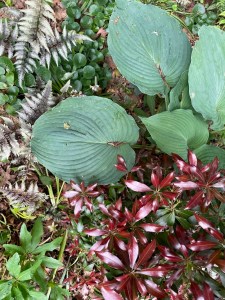
Ficus Benjamina, Red Banana, Merlin, Millie, Alocasia ‘Sarian, Bird of Paradise (Strelitzia nicolai), Colocasia ‘Coffee Cups’. Barely visible: Society Garlic (Tulbaghia Violacea ‘Variegata’), Colocasia ‘Black Magic’)
Most of the tropicals that overwintered as houseplants above. The colocasias, alocasias, Bird of Paradise, Society Garlic and the not-pictured lemongrass overwinter in dishes filled water.
I do have a NOID colocasia I overwinter as a tuber as I do with dahlias – cut the foliage off, let it dry, bury it in heavy cardboard box surrounded by wadded up paper bags, leave it in the basement over winter. I may treat it as the others this winter, because that time frame from February to May where they are actively growing, getting more sun, getting fertilized, is probably ultimately better for long-term survival.
I try not to bank on these though – the oldest is Sarian, which overwintered first in 2022. Conversely, I’ve had that ficus for twenty-five years.
Apart from the ficus, all of these seem happiest in an inch or two of water and an airy soil mix. Despite being moisture-lovers, they are prone to root rot, so air circulation is important and they get extra perlite and live in clay pots. During the winter, some need to be refilled daily – ‘Sarian’ goes through a pint to a liter per day, others a bit slower, but it is a daily activity to check on them during the winter. Gets a little tedious by May (I bring them in around Labor Day, so they spend around eight months of the year as houseplants – their neediness doesn’t really ramp up until November.)
The colocasias and alocasias are prone to guttation, which is this fascinating thing where you give them water and capillary action pulls the water from the roots to the tips of the leaves, and if you are sitting on the couch below one you will suddenly be dripped on by the water that beads at the tips of their leaves.
I begin fertilizing when they start growing as the days get longer in January. The tropicals are heavy feeders (the ficus less so).
There are a hundred other ways to handle tropicals in unnatural environments, including playing with dormancy, less half-assed hydroponics – I like the particular method I use because I enjoy seeing tropical plants hanging out in a room with a fireplace in the middle of a snow storm, so I will put in the effort. Another method would be to enjoy them in the summer and chuck ’em.
Most get at least a little etiolated but I have clip on grow lights I move around as needed, and since the house is cold they aren’t putting on that much growth.
The Society Garlic, Bird of Paradise, and Lemongrass are problem free. ‘Coffee Cups’ for some reason is more prone to spider mites. Everyone gets special attention on Sundays in the winter when I make the rounds to check for diseases and pests.
The ficus has been prone to scale the past few years but with the generous support from my daughter we have spent many hours in a trance removing scale insects with Q-tips dipped in rubbing alcohol, and this year we figured out to target the eggs as well (they appear as cottony-white smears on the under side of the leaves, so it was much less of an issue this year. I’ve also heard of people taking them outside, spraying them with Lysol, hosing them down, and bringing them back in for large infestations. I may try it sometime, but for now I’m content with seeing pest control for tropicals in a dry, New England winter as a minor war of attrition I don’t need to win: I just don’t want to lose.
The banana overwinters in the basement and I bring it up in…March? I think. The basement is in the 50 degree range. There is a small window. It does not get watered and eventually looks pretty unhappy, but importantly: not dead. No pests. This year I will likely trim all leaves by half as it is more mature at this point.

Third time’s a charm. I found a place the Shredded Umbrella Plant can survive. Added in the September of 2024.

My favorite rhododendron – they look like such weirdoes.

Glossy burgandy leaves, silvery grey, matte blue is one of my favorite color combinations – inspired by the leaves of the Japanese Painted Fern.

A stream crosses the front of our property and on the other side is swampland, or ‘wetlands’, to give it a positive spin. Jeff put up a bridge this year and started laying the ground work for paths on that side. When I finally got a chance to go look around I found fields of these, which I’d never come across before.

Ruthie doesn’t get out much and doesn’t go far when she does, but she always seems so amazed by everything.

Merlin had knee surgery this year; nice to see him sprawling around in the sun. We have made it a point to not mow the Bluets in the spring and we have great swaths of them in the lower part of the yard.
I think no-mow May is a fools game but we don’t mow near the leaf litter nor over the bluets. Some of those other early spring weeds, though…they have to be mowed because they are so prolific I spent Summer 2023 and 2024 removing them from the vegetable garden.
Ideally everything would be planted and this wouldn’t be an issue, but at this time we do indeed have a lawn.
